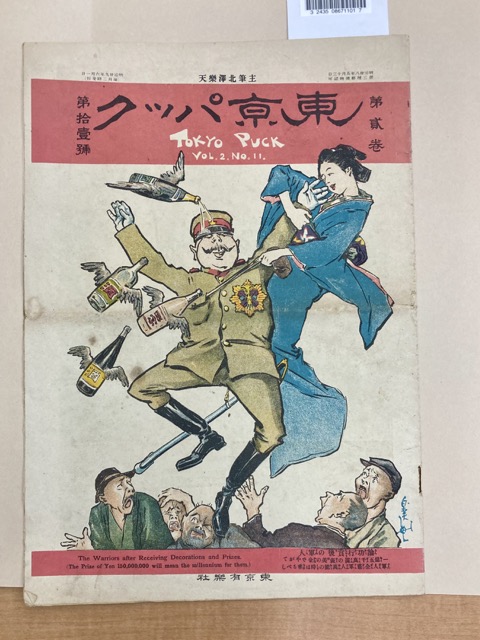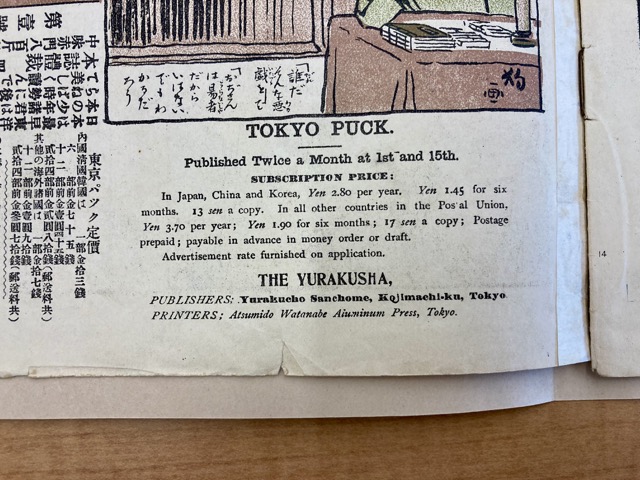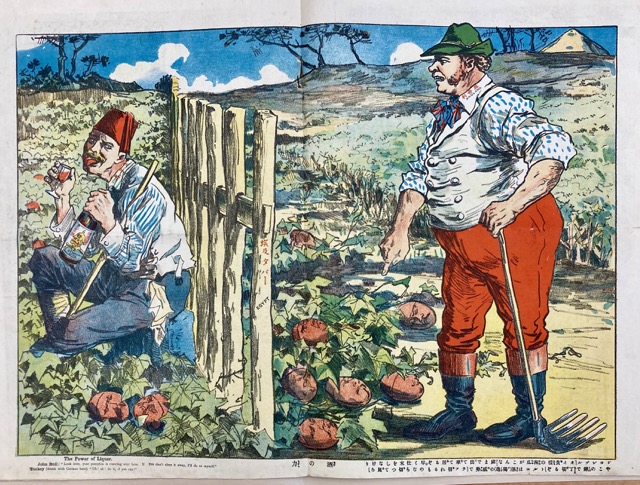Among the many unique manga serials held at OSU’s Billy Ireland Cartoon Library & Museum (BICLM) are three original issues of Tokyo Puck (東京パック), an early Japanese satirical comic newspaper launched by Kitazawa Rakuten (北沢楽天, 1876-1955) and published from 1905 to 1923 (with a 5-year interruption circa the First World War). This Japanese manga newspaper was inspired by the American magazine Puck (published from 1877 to 1918), one of the earliest humor magazines in the US to solely feature cartoons, caricatures, and political satire.

The cover page of an issue of Tokyo Puck (Volume 2, Number 11, published June 1, 1906), held at the BICLM. PN6790.J32 T65 v.2:no.11
Recently I had the opportunity to click some pictures of two of our Tokyo Puck issues during a class visit with students from “The Art of Colonial Taiwan,” (ArtHist 5002). In addition to our Tokyo Puck samples, the students in this class browsed a variety of materials depicting Taiwan and other Japanese colonies in historical cartoon maps, water colors, and artist scrolls created by famous manga artists of the early 20th century.

Image of a bilingual colophon indicating the international audience and location-based subscription pricing plan, among other details.
A detail that I was fascinated to discover about Tokyo Puck was that it was sold not only in Japan, but also in China and Korea in the early 20th century. Additionally, international readers “in all other countries in the Postal Union” could access this journal for a slightly higher fee. (This tracks with a report I heard recently that Tokyo Puck was available to subscribers on the West Coast in the US, too!)
Another noteworthy feature was the bilingual format of these samples. Cartoon titles, commentary, and the newspaper colophon were often printed in both English and Japanese. Per early twentieth century practice, the Japanese text was written from top to bottom and right to left, and print characters often appeared with furigana, a phonetic notation that indicates how to read the characters. In addition to English translations, much of the first arc of the magazine was, in fact, trilingual with Chinese captions, at least from the third year of publication.
Interestingly, roman numerals were inserted in each cartoon panel signaling the directional flow of the graphic narrative. The two comics pictured in the image below, for example, followed the traditional Japanese manga reading style: Starting with the panels on the upper right corner, the story lines moved downward toward the bottom right corners and then up to the proceeding columns on the left. Ultimately, the stories ended in the bottom left-hand corners.
Given the bilingual nature of the comics, as well as the glosses in furigana, Japanese language learners might enjoy reading such humorous newspapers as an alternative form of language study. Offering a unique window to early twentieth century culture, such satirical newspapers poked fun at wide-ranging topics from international politics (e.g., imperialist border squabbles), to Japanese militarism (e.g., the foibles of a decorated soldier), and family gender dynamics (e.g., name-calling between husband and wife) as pictured in these insets.

A page from the Tokyo Puck. The comic strip on the top half lampoons the indiscriminate and “fanatic” practice of collecting picture postcards. The lower comic strip pokes fun at the squabbles between a cartoon artist and his wife.
In addition to these original serials, our library holds reprints of the entire Tokyo Puck series in print (stored at the BICLM) and online (via the Kinoden eBook database). Please let us know if you would like to learn more about accessing any of these materials for your scholarship or teaching!

This two-page cartoon, entitled “The Power of Liquor” (Sake no chikara) satirizes a territorial dispute between England (represented by a rather corpulent and bossy man in red pants) and Turkey (getting drunk on German wine). The two men are separated by a fence with the word Egypt on it, and pumpkins (representing – presumably – the heads of various statesmen) are growing on both sides.
Note: These images may be protected by copyright and are intended only for educational or research purposes.
Credit line: The Ohio State University, Billy Ireland Cartoon Library and Museum
Further Reading:
“Japanese Mythological Modernism: The Story of Puck and the Appearance of Kindaijin” by Roman Rosenbaum, in Rethinking Japanese Modernism, edited by Roy Starrs (Brill, 2011).
Manga: a critical guide by Shige (CJ) Suzuki and Ronald Stewart (Bloomsbury Academic, 2023).
Manga zasshi hakubutsukan, an anthology of historical manga. (See especially volumes 5 and 7) by Shimizu Isao (Kokusho Kankōkai, 1986-1987).
Rewriting history in manga : stories for the nation, edited by Nissim Otmazgin, Rebecca Suter, (Palgrave Macmillan, 2016).

